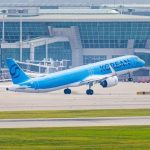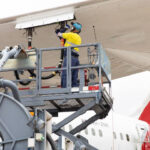The Climate Change Committee, which advises the UK government on tackling climate change and proposes the pathway for the nation to achieve net zero emissions by 2050, has published its Seventh Carbon Budget (CB7) that covers the period 2038-2042. As other industries decarbonise faster, aviation will move from being the sixth highest emitting sector to the become the highest, alongside agriculture, during the carbon budget period, with a 27% share of total UK emissions. The Committee foresees aviation contributing to a 5% share of total UK emissions reduction through a gradual increase in the use of sustainable aviation fuels, a growing portion of this coming from synthetic fuels, and demand growth management by ensuring the cost of decarbonising the sector is reflected in the price of flying. During this period, engineered carbon removals are expected to be deployed at scale.
The Committee recommends the level of the Seventh Carbon Budget is 535 MtCO2e, including emissions from international aviation and shipping. This is 87% below 1990 levels, although aviation emissions will be 69% higher than 1990.
It forecasts that by 2040, aviation emissions, which currently account for 8% of all UK emissions, will fall by 17% relative to 2023, from 35.4 MtCO2e to 29.5 MtCO2e. This will be driven by a mix of technology efficiency improvements, the growing use of SAF and by the sector paying, through the ‘polluter pays’ principle, to support engineered carbon removals. By 2050, aviation emissions fall to 22.7 MtCO2e, a 36% decrease from 2023.
“The aviation sector needs to take responsibility for its emissions reaching Net Zero by 2050,” says the Committee. “The cost of decarbonising aviation and addressing non-CO2 effects should be reflected in the cost to fly. This will help manage growth in aviation demand in line with Net Zero.”
The Committee is clear in its 400-page Seventh Carbon Budget report that aviation demand can only grow if technology roll-out progresses and begins to abate and offset aviation emissions. In its ‘Balanced Pathway’ for aviation, the largest share of emissions reduction by the CB7 period comes from managing forecast aviation demand growth. This is followed by SAF uptake, efficiency improvements and the roll-out of hybrid-electric and battery-electric aircraft.
Land or nature based measures including planting new woodland and restoring peatlands will be integral to ensure that agriculture, the other most hard-to-abate sector, reaches Net Zero, whereas permanent engineered removals will be necessary to balance remaining aviation emissions that cannot be abated by in-sector means.
These removals are most likely to be delivered through BECCS (bioenergy with carbon capture and storage), DACCS (direct air carbon capture and storage), enhanced weathering and biochar. Removals will play an increasing role in contributing to the 2050 net zero UK target in order to offset ongoing emissions. As the market scales up and demand to offset residual emissions grows, the cost of removals are projected to fall and the Committee forecasts the average cost to be £324/tCO2 ($410/tCO2) by 2040.
The CB7 report expects aviation, including its share of removals, to decarbonise at a similar pace to most other sectors, but starting later as technological solutions – including SAF and engineered removals – are at an earlier stage of development than in other sectors.
However, it acknowledges: “While engineered removals play the largest role in reducing combined emissions to zero in our pathway, the exact balance between SAF, engineered removals and demand remains uncertain and this share could be different in practice.”
The report forecasts SAF to meet 17% of aviation fuel demand by 2040, although with the “uncertainty” caveat attached. This contrasts with the UK government’s SAF Mandate requirement for SAF to make up 22% of all UK aviation fuel use in 2040. The Committee attributes its lower expectation to anticipated international feedstock supply constraints in the late 2020s and 2030s, long-term uncertainties over SAF costs, particularly synthetic fuels, and projected cost effectiveness of engineered removals compared to SAF. The Committee estimates that DACCS may be more cost-effective compared to producing synthetic fuels during the CB7 period, both of which will be available to the aviation sector from the mid-2030s.
By 2050, all residual aviation emissions are expected to be offset using permanent engineered removals, with the sector accounting for around 60% of total engineered removals. If it is assumed that aviation receives around the same share of available removals in 2040, this equates to around 13 MtCO2e of removals.
Under the Committee’s Balanced Pathway, per-capita aviation passenger-kms in 2040 are 16% above 2025 levels, with demand growth from the mid-2030s contingent on low-carbon technologies being available.
“Aviation demand can only grow if aviation sector technology roll-out progresses and begins to abate and offset aviation emissions, with demand management playing an important role in the 2020s and 2030s while availability of SAF and engineered removals is limited,” says the report. “As a result, per-capita passenger-kms remain relatively flat between 2025 and the early 2030s.
“As SAF and engineered removals become more widely used from the mid-2030s, passenger demand then grows from this point. This growth is conditional on these technologies developing as projected.”
Since aviation will be one of the UK’s highest-emitting sectors by the CB7 period, measures to manage demand could also offer sizeable additional savings, especially if SAF has not scaled up as planned and aviation emissions are not developing in line with Net Zero, says the report. In which case, it adds, “The government and the aviation industry will need to be ready to implement more demand management policy.”
The CB7 report calls on the government to push for higher international ambition through ICAO and the CORSIA carbon offsetting scheme. “The UK should also pursue opportunities to go further, such as forming progressive alliances with countries who are aligned with the UK,” it adds.
The government has shown a commitment to include emissions from international aviation and shipping in the Sixth Carbon Budget (2033-2037) and Net Zero but has not included them in the UK’s Nationally Determined Contribution, its climate pledge under the Paris Agreement.
The purpose of the Carbon Budgets and the setting of the budget level 12 years in advance of the period in question is to provide a long-term signal on the UK’s direction of travel in meeting climate change targets. The Climate Change Act, which was introduced in 2008 and established the Climate Change Committee, requires the government to produce a report setting out proposals and policies for meeting carbon budgets, including the timescales over which these are expected to take effect.
“Markets alone cannot drive the Net Zero transition,” notes the Committee’s CB7 report. “Policy is needed to provide confidence to investors and consumers, manage risks in new markets, remove barriers to delivery and, in some cases, provide financial incentives where necessary.”
Reaction by aviation stakeholders to the Committee’s analysis and recommendations:
Gary Elliott, CEO of the Aerospace Technology Institute:
“CB7 highlights the immense challenge of decarbonising aviation compared with other sectors. It also demonstrates the size of the prize that developing ultra-efficient, zero-carbon emission and cross-cutting aircraft technologies represents for the UK economy and global environment. The report notes the exact balance between abatement measures is uncertain, underlining the importance of developing a portfolio of technologies. CB7 forecasts that aviation’s share of UK carbon emissions will grow from 8% today to around 25% in 2040 as other sectors decarbonise. This is driven by a forecasted growth in passenger demand as air travel becomes more accessible to a growing population globally. This increasing passenger demand is an important part of the investment case for developing new technologies and is a driver for economic growth, as recognised by the government’s support for the expansion of UK airports. Constraining demand would be a risk to both.”
Karen Dee, Chief Executive of UK airports trade association AirportsUK:
“We are pleased the CCC has recognised the work being done by the sector to decarbonise and the role this will play in enabling sustainable expansion at our airports. We’ll continue working with the Committee as it refines its positions and assumptions on passenger numbers, the impact of the SAF mandate and other policy measures that are coming on stream. In the meantime, airports are committed to delivering sustainable economic growth, as outlined by the Chancellor in her Oxford speech last month, and to creating new jobs, bringing in new investment and driving new regional opportunities.”
UK environment group Aviation Environment Federation:
“CB7 demonstrates that any airport expansion would undermine the CCC’s trajectory for ‘balanced’ growth to deliver net zero. In addition, the budget’s uncertainty over the delivery of SAF shows there are considerable risks in failing to contain the growth of the sector’s emissions in the near term. This report casts a huge shadow over any UK airport expansion plans. The CB7 balanced pathway to deliver net zero by 2050 forecasts there will be 400 million passengers using UK airports by 2050 but currently available UK airport capacity is already in excess of this figure. The report envisages no growth in UK passenger demand over the next five years, increasing by 2% by 2035, and just 10% by 2040 – undermining the growth case for all UK airports.”
Celeste Hicks, AEF Policy Manager, said: “The Committee’s analysis leaves no room for misinterpretation, the government must do more to ensure the industry decarbonises quickly. Based on the evidence presented, there’s simply no justifiable rationale for airport expansion. We would welcome further advice from the Committee on how the government can deliver reductions beyond its recommendation that the industry should pay for the costs of SAF and removals.”
NGO group Transport & Environment:
“The aviation sector is on course to be the UK’s most polluting sector, making up 27% of UK emissions in 2040, according the report, which warns against growing aviation demand until green technologies are scaled up. The report acknowledges that supplies of sustainable jet fuels will be constrained. However, it prioritises unproven carbon capture over demand management and firm proposals to accelerate scale up of green fuels.”
Anna Krajinska, UK Director at T&E, said: “As the UK’s own advisors are warning against runaway aviation emissions, the government is committing to airport expansion. By letting air travel off the hook, the government risks putting the burden on other sectors to cut their emissions and being reliant on unproven carbon capture. With just half of Britons flying every year, this would be incredibly unfair.”
Aoife O’Leary, CEO of climate change NGO Opportunity Green:
“The UK government’s top climate advisors show that the aviation sector will make up a quarter of all emissions in 2040 – a staggering increase from where it stands at the moment at 7%. This is even with much more stringent measures than are currently in place, showing just how important it is to step up regulation to reduce emissions immediately. The only other sector which is projected to emit nearly as many emissions in 2040 is agriculture, begging the question of whether flying should really be given the same priority as the farmers feeding the UK population.”
Nuala Doyle, Policy Officer at aviation and shipping group The SASHA Coalition:
“The Climate Change Committee’s carbon budget recommendation paints a worrying picture for aviation, with the sector becoming the UK’s biggest polluter by 2040. Avoiding this scenario requires action today: scaling up e-kerosene production as a matter of priority by dedicating specific support to e-fuel producers in the revenue support mechanism, and in the long term strengthening the SAF mandate’s e-fuel sub-targets. A key lever will also be extending the UK ETS to cover all aviation and non-CO2 emissions, such as contrails. This would make aviation pay fairly for all its climate impacts, and unlock more finances to drive the transition and realise the growth potential of the green aviation sector not yet tapped.”
Photo: Heathrow Airport















More News & Features
SkyNRG says e-SAF and carbon removals should not be competing strategies for aviation decarbonisation
South Korea announces mandatory SAF blending for departing international flights from 2027
Catagen launches SAF production company and signs offtakes with Ryanair and Shell
Australia announces A$1.1bn incentive scheme to drive local production of low carbon fuels including SAF
Oneworld airline partners join with Breakthrough Energy Ventures to invest in new SAF technologies
New Danish measures emerge to reduce aviation’s air and ground emissions